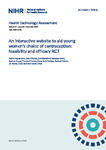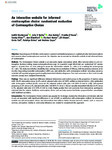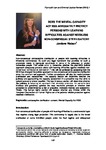An interactive website to aid young women’s choice of contraception: feasibility and efficacy RCT
| dc.contributor.author | Stephenson, J | |
| dc.contributor.author | Bailey, JV | |
| dc.contributor.author | Blandford, A | |
| dc.contributor.author | Brima, N | |
| dc.contributor.author | Copas, A | |
| dc.contributor.author | D’Souza, P | |
| dc.contributor.author | Gubijev, A | |
| dc.contributor.author | Hunter, R | |
| dc.contributor.author | SHAWE, JILL | |
| dc.contributor.author | Rait, G | |
| dc.contributor.author | Oliver, S | |
| dc.date.accessioned | 2021-11-11T13:56:06Z | |
| dc.date.issued | 2020-11 | |
| dc.identifier.issn | 1366-5278 | |
| dc.identifier.issn | 2046-4924 | |
| dc.identifier.uri | http://hdl.handle.net/10026.1/18326 | |
| dc.description.abstract |
Background Effective use of contraception can reduce numbers of unintended pregnancies, but misunderstandings and concerns about contraception abound. Increasingly, women seek health-care information online. Objectives To develop an interactive website to aid informed choice of contraceptive method, including long-acting reversible contraception (Phase I), and test its effectiveness in a parallel, single-blind randomised trial (Phase II). Approval came from London – Camden & King’s Cross Research Ethics Committee (reference 17/LO/0112). Setting and participants For both phases, women aged 15–30 years were recruited from general practice, sexual health services, maternity services, community pharmacies and an abortion service. Design In Phase I, we conducted three systematic literature reviews, a review of YouTube (YouTube, LLC, San Bruno, CA, USA) videos about contraception, and focus groups and interviews with young women to explore barriers to and concerns and misperceptions about contraception. We then iteratively co-designed an interactive website, Contraception Choices [URL: www.contraceptionchoices.org (accessed June 2020)], with young women and a software company. In Phase II, we evaluated the website through a randomised trial that began as a feasibility trial. Early demand for Contraception Choices stimulated a design change from a feasibility to an efficacy trial, with follow-up for clinical outcomes at 3 and 6 months. A randomisation list was incorporated into the trial software program to allocate participants to the intervention (website) or control group (standard care). Intervention Contraception Choices is a co-designed, evidence-based, interactive website to aid informed choice of contraception. It provides information about different methods, addresses common concerns and offers tailored contraceptive options in response to individual preferences. Main outcome measures Qualitative – participant views and experience of the intervention, assessed through qualitative interviews. Quantitative primary outcomes – follow-up rate at 6 months in the initial feasibility trial, using a long-acting reversible contraception method, and satisfaction with contraceptive method at 6 months in the efficacy trial. Results A total of 927 women were randomised online to the website (n = 464) or control group (n = 463), of whom 739 (80%) provided follow-up data at 6 months [786 women (85%) provided data at 3 and/or 6 months that were included in the analysis of primary outcomes]. There was little difference between groups in the proportion using long-acting reversible contraception at 6 months [30.4% intervention vs. 31.0% control, adjusted odds ratio after imputation 0.87 (95% confidence interval 0.60 to 1.27)] or in satisfaction with contraceptive method [proportion being ‘satisfied’ or ‘very satisfied’, 82.6% intervention vs. 82.1% control, adjusted odds ratio 0.93 (95% confidence interval 0.69 to 1.25)]. Qualitative evaluation indicated highly positive views about the website and increased knowledge of contraceptive methods that could dispel misperceptions. Women appreciated having information tailored to their specific needs and felt better prepared before consultations. Limitations We did not include intermediate measures, such as knowledge of contraceptive methods, intention to change method or confidence in discussing contraception with a health-care professional, which may have indicated other benefits of using the website. In future, the website should be studied in different settings (e.g. schools and in routine practice) to see whether or not it improves the quality or efficiency of contraceptive consultations. Conclusions Our systematic review indicated wide-ranging influences on women’s use of contraception globally. The website, Contraception Choices, was very popular with young women and contraception service providers. It was not associated with statistically significant differences in use of long-acting reversible contraception or satisfaction with contraceptive method at 6 months. Trial registration Current Controlled Trials ISRCTN13247829. Funding This project was funded by the National Institute for Health Research (NIHR) Health Technology Assessment programme and will be published in full in Health Technology Assessment; Vol. 24, No. 56. See the NIHR Journals Library website for further project information. | |
| dc.format.extent | 1-44 | |
| dc.format.medium | ||
| dc.language | en | |
| dc.language.iso | en | |
| dc.publisher | NIHR Journals Library | |
| dc.subject | CONTRACEPTION | |
| dc.subject | CONTRACEPTIVE METHODS | |
| dc.subject | DIGITAL HEALTH | |
| dc.subject | INTERACTIVE DIGITAL INTERVENTION | |
| dc.subject | RANDOMISED CONTROLLED TRIAL | |
| dc.subject | Adolescent | |
| dc.subject | Adult | |
| dc.subject | Choice Behavior | |
| dc.subject | Community Pharmacy Services | |
| dc.subject | Contraception | |
| dc.subject | Feasibility Studies | |
| dc.subject | Female | |
| dc.subject | General Practice | |
| dc.subject | Health Education | |
| dc.subject | Humans | |
| dc.subject | Internet | |
| dc.subject | Long-Acting Reversible Contraception | |
| dc.subject | Maternal Health Services | |
| dc.subject | Patient Preference | |
| dc.subject | Reproductive Health Services | |
| dc.subject | Single-Blind Method | |
| dc.subject | United Arab Emirates | |
| dc.subject | Young Adult | |
| dc.title | An interactive website to aid young women’s choice of contraception: feasibility and efficacy RCT | |
| dc.type | journal-article | |
| dc.type | Journal Article | |
| dc.type | Randomized Controlled Trial | |
| dc.type | Research Support, Non-U.S. Gov't | |
| plymouth.author-url | https://www.webofscience.com/api/gateway?GWVersion=2&SrcApp=PARTNER_APP&SrcAuth=LinksAMR&KeyUT=WOS:000587747400001&DestLinkType=FullRecord&DestApp=ALL_WOS&UsrCustomerID=11bb513d99f797142bcfeffcc58ea008 | |
| plymouth.issue | 56 | |
| plymouth.volume | 24 | |
| plymouth.publication-status | Published online | |
| plymouth.journal | Health Technology Assessment | |
| dc.identifier.doi | 10.3310/hta24560 | |
| plymouth.organisational-group | /Plymouth | |
| plymouth.organisational-group | /Plymouth/Faculty of Health | |
| plymouth.organisational-group | /Plymouth/Faculty of Health/School of Nursing and Midwifery | |
| plymouth.organisational-group | /Plymouth/REF 2021 Researchers by UoA | |
| plymouth.organisational-group | /Plymouth/REF 2021 Researchers by UoA/UoA03 Allied Health Professions, Dentistry, Nursing and Pharmacy | |
| plymouth.organisational-group | /Plymouth/Research Groups | |
| plymouth.organisational-group | /Plymouth/Research Groups/Institute of Health and Community | |
| plymouth.organisational-group | /Plymouth/Research Groups/Plymouth Institute of Health and Care Research (PIHR) | |
| plymouth.organisational-group | /Plymouth/Users by role | |
| plymouth.organisational-group | /Plymouth/Users by role/Academics | |
| dc.publisher.place | England | |
| dcterms.dateAccepted | 2020-11-01 | |
| dc.rights.embargodate | 2021-11-12 | |
| dc.identifier.eissn | 2046-4924 | |
| dc.rights.embargoperiod | Not known | |
| rioxxterms.versionofrecord | 10.3310/hta24560 | |
| rioxxterms.licenseref.uri | http://www.rioxx.net/licenses/all-rights-reserved | |
| rioxxterms.licenseref.startdate | 2020-11 | |
| rioxxterms.type | Journal Article/Review |





